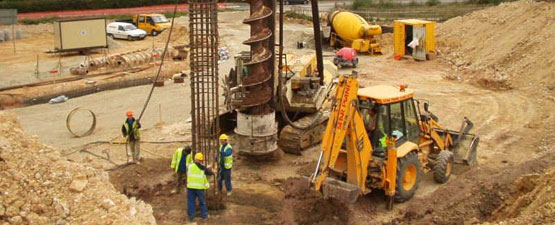The Interdisciplinary Approaches in the Geotechnical Sector: Bridging the Gap In Between Engineering, Geology, and Environmental Scientific Research for Ideal Project End Results
The combination of engineering, geology, and environmental science within the geotechnical market is not merely useful; it is essential for accomplishing ideal project end results. This interdisciplinary collaboration cultivates a comprehensive understanding of complex website problems, allowing for innovative services to emerge. By taking a look at crucial roles and effective study, we can uncover the vibrant interplay that drives project success. Nevertheless, obstacles stay in successfully managing these multidisciplinary initiatives, increasing concerns concerning prospective advancements and future trends. What techniques might arise to facilitate this crucial cooperation and enhance the efficacy of geotechnical methods?
Importance of Interdisciplinary Collaboration
The relevance of interdisciplinary collaboration in the geotechnical market can not be overstated. Reliable geotechnical tasks require the integration of varied competence from different areas, consisting of engineering, geology, and ecological science. This partnership ensures that all facets of a task are taken into consideration, bring about comprehensive services that address complex challenges.
When functioning in seclusion,Interdisciplinary collaboration promotes advancement by allowing specialists to share understandings and techniques that might not be obvious. By leveraging the staminas of multiple disciplines, teams can recognize potential dangers, maximize layout processes, and improve the sustainability of geotechnical projects. Such collaboration advertises an all natural understanding of site-specific problems, which is important for accurate analysis and decision-making.
The complexity of geotechnical jobs demands a coordinated method to analytic. Eventually, interdisciplinary partnership is crucial for progressing finest practices and achieving quality in the geotechnical industry.
Key Roles of Each Technique
Collaboration among various self-controls is not just advantageous; it is vital for the effective implementation of geotechnical jobs. Each technique-- engineering, geology, and ecological scientific research-- plays a distinctive yet interconnected role that adds to project efficiency and sustainability.
Geotechnical designers are largely liable for making foundations and guaranteeing structural honesty. They analyze dirt and rock residential properties to evaluate load-bearing capabilities, providing crucial information for risk-free construction techniques. Their knowledge allows the formula of cutting-edge remedies to complicated obstacles.

Ecological scientists evaluate the prospective impacts of building on ecological communities and water sources. They carry out ecological analyses and establish reduction methods to reduce unfavorable results. By incorporating environmental considerations, they make sure conformity with guidelines and promote sustainability throughout the task lifecycle.
Study of Effective Integration
Successful assimilation of geotechnical techniques can be exhibited through different case researches that highlight the effectiveness of synergy in dealing with intricate engineering obstacles. One notable instance is the construction of the Hong Kong-- Zhuhai-- Macau Bridge, where a collaborative method entailing geotechnical design, geology, and environmental scientific research was critical. Engineers and geologists operated in unison to analyze the seabed conditions and enhance the structure design, making certain stability and minimizing environmental influence.
Another impactful case is the enhancement of incline stability in the San Francisco Bay Location, where an interdisciplinary team integrated geotechnical evaluation with ecological evaluations. By incorporating geological surveys and hydrological studies, the team successfully identified potential landslide threats and executed efficient reduction measures, boosting safety and sustainability.
Additionally, the redevelopment of Brownfield websites typically calls for a multidisciplinary method. In one situation in Chicago, cooperation among geotechnical engineers, ecological researchers, and metropolitan coordinators led to the effective remediation of infected dirt, allowing for the risk-free makeover of the site into a neighborhood park. These study highlight that interdisciplinary collaboration not only addresses technical difficulties yet also cultivates cutting-edge options that benefit both projects and areas.
Difficulties in Multidisciplinary Projects

In addition, working with routines and operations among various teams can be problematic, specifically when each technique has distinct project landmarks and deliverables. This imbalance can result in hold-ups and enhanced prices. The challenge of resource appropriation additionally looms big; making sure that specialized knowledge is readily available at important points calls for careful preparation and foresight.
Last but not least, governing compliance poses one more substantial difficulty. Each technique might face various regulatory structures, and straightening these needs to satisfy project purposes can be time-consuming and intricate. Dealing with these difficulties necessitates solid management and efficient interaction techniques to cultivate cooperation and make certain that multidisciplinary groups work cohesively in the direction of shared goals.
Future Trends in Geotechnical Practices
As the geotechnical market progresses, arising trends are improving techniques to deal with the obstacles faced go to these guys in multidisciplinary jobs - geotechnical engineers. One considerable fad is the raised integration of sophisticated modern technologies, such as expert system and maker knowing, into geotechnical analysis and style. These modern technologies improve predictive modeling and threat evaluation, allowing engineers to make more enlightened choices throughout the task lifecycle

Additionally, the fostering of digital twins and real-time surveillance systems is becoming extra common. These devices help with recurring analysis of dirt conditions and architectural performance, permitting timely treatments when problems emerge.
Conclusion
To conclude, the combination of design, geology, and environmental scientific research is important for attaining ideal outcomes in the geotechnical industry. Interdisciplinary partnership promotes innovation, improves analytic capabilities, and straightens technological needs with environmental sustainability. Successful instance researches show the benefits of this approach, while recognizing the difficulties dealt with in multidisciplinary jobs. Looking in advance, welcoming try here these collaborative techniques will be important for browsing future patterns and progressing the area of geotechnical engineering.
The assimilation of design, geology, and environmental scientific research within the geotechnical industry is not simply helpful; it is crucial for achieving optimum task outcomes. Reliable geotechnical tasks require the combination of varied experience from various areas, consisting of design, geology, and environmental scientific research.Navigating the intricacies of multidisciplinary projects in the geotechnical market offers several substantial challenges.As the geotechnical market evolves, emerging patterns are reshaping practices to deal with the obstacles faced in multidisciplinary projects. Geotechnical engineers are progressively teaming up with environmental scientists to ensure that jobs line up with sustainability goals and abide with governing demands.